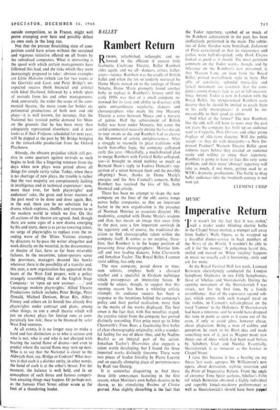Rambert Return
BALLET REBORN, refurbished, rethought, and re- housed in the efficient if austere little Jeannetta Cochrane Theatre, Ballet Rambert rides again, and we all—dancers, critics, ballet- goers—rejoice. Rambert was the cradle of British ballet and when the tot so tenderly nurtured by Dame Marie moved on to the tutelage of Dame Ninette, Dame Marie promptly found another baby to replace it. Rambert's history until the early 1950s was that of a small company re- nowned for its taste and ability to discover, with quite extraordinary regularity, dancers and choreographers who made the tiny Mercury Theatre a cross between Mecca and a nursery of genius. Half the achievement of British ballet was born under Mercury, but came the awful commercial necessity during the last decade to tour swans or die and Rambert had to choose the Mammon of artistic unrighteousness. After a struggle to reconcile its great traditions with harsh box-oflice logic, the company collapsed early this year. (Mercifully, a much-bruited plan to merge Rambert with Festival Ballet collapsed, too—it brought to mind nothing so much as Bernard Shaw's reply to Isadora Duncan's sug- gestion of a union between them and the possible offspring.) Now, thanks to Dame Marie's energies and the Arts Council's concern, Ballet Rambert has received the kiss of life, both financial and artistic.
There has been no attempt to shape the new company on the lines of the old; autres temps autres ballet companies, so that an important factor in the new organisation is the presence of Norman Morrice as associate director. His modernity, coupled with Dame Marie's wisdom and élan, has meant an image that owes little to the past, save a few important survivals in the repertory and, of course, the traditional de- cision to find choreographic talent within the company itself. It comes as no surprise, there- fore, that Rambert is in the happy position of possessing three choreographers: Morrice him- self and two leading dancers, John Chesworth and Jonathan Taylor. The Royal Ballet, I cannot resist adding, has only one.
The new company, pared down to nine- teen soloists, employs both a classical teacher and a specialist in Graham technique which presupposes an interesting future. It would be unjust, though, to suggest that this opening season has been a whizzing artistic triumph; its audience success has been a response to the intentions behind the company's policy and their partial realisation, more than to the merits of the works displayed. The best omen is the fact that, with five novelties staged, the creative talent from the company has proved distinctly rewarding. First prize must go to John Chesworth's Time Base, a fascinating first ballet of clear choreographic originality, with a wonder- ful feeling for use of decor (fine, and by Nadine Baylis) as an integral part of the action. Jonathan Taylor's Diversities also suggests a talent worth developing, but I found the three imported works distinctly tiresome. These were two pieces of leaden frivolity by Pierre Lacotte and an equally clumping piece of portentousness by Rudi van Danzig.
It is somewhat disquieting to find these three little annoyances featuring in the first season, when Morrice's own ballets deserve to be shown, as his stimulating Realms of Choice proved. Also slightly disturbing is the fact that the Tudor repertory, symbol of so much of the Rambert achievement in the past, has been ineffectively performed in the main. The subtle- ties of Lilac Garden were brutalised, Judgment of Paris caricatured so that its viciousness and pathos were half-dissipated; only Dark Elegies looked as good as it should. The most pertinent comment on the Tudor works, though, and by inference on the Rambert's new personnel, is that Maryon Lane, on loan from the Royal Ballet, proved marvellously right in them. Her gifts of sensitivity, splendid musicality and lyrical movement are essentials that the com- pany's young dancers lack as ■ ct in full measure. Since Antony Tudor is now in London with the Royal Ballet, the inexperienced Rambert casts deserve that he should be invited to coach them in his early masterpieces: it would be im- measurably to their good as artists.
And what of the future? The new Rambert, like the old, will still have to tour; over the past ten years the company has built up an audience used to Coppelia, Don Quixote and other prime displays of olde-tyme dancing. Will the public accept—as they do with detergents—a New Im- proved Product? Western Theatre Ballet spent arduous years before they created an audience ready and willing to enjoy their repertory. Rambert is going to have to face this very same problem, and their more 'abstract' repertory will take as much, if not more, getting used to as WTB's dramatic productions. The battle to drag ballet audiences into the twentieth century is not won yet.
CLEMENT CRISP






























 Previous page
Previous page